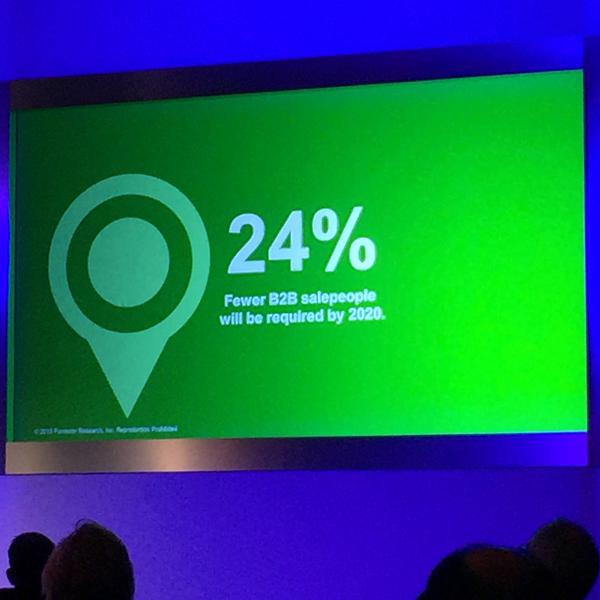People have been talking about the death of B2B sales and marketing for a while now — heck, I even did so in March of 2015 with this post and this graphic:
That slide was captured at something called the ‘Sales Enablement Forum,’ which was an event hosted by Forrester Research in Scottsdale, Arizona. (It appears a similar event this year will instead be held online.)
The whole idea of the death of B2B sales and marketing comes from the concept of self-research, or self-service. Essentially, it goes like this:
- If everyone is producing more content about their products and services, then …
- Shouldn’t people be able to read/view that content and be guided through the sales process that way?
- Wouldn’t that eliminate the need for most B2B salespeople and some B2B marketers?
Not so fast, my friend.
The death of B2B sales and marketing is on pause because…
Let’s go back to Forrester and a more recent post called “How Self-Service Research Will Change B2B Marketing.” It has a lot of good information in it, and this section might be among the best:
But it’s still too difficult for prospects to find the content they need. As Laura Ramos pointed out in her report B2B Content Fails The Customer Engagement Test, the best content matching the buyer’s research needs is too often missing or buried deep in vendor websites, typically hidden under a “resources” tab. This structure might make sense to a website designer or content manager, but it’s unhelpful to the business buyer. Another impediment to self-service research is site search, which all too often returns an undifferentiated — and unhelpful — list of content that includes press releases, blogs, and documentation.
If you read the entire pull quote, here’s what we have essentially come to:
- The death of B2B sales and marketing should be coming soon
- It won’t, though
- The reason?
- Baby Boomers who run departments don’t really understand digital and how to maximize it
I’ve encountered this at every single job I’ve ever had. It tends to flow something like this:
- Digital doesn’t make people as much money
- As a result, the leaders and decision-makers tend to ignore it or gloss it over
- As a result of that, nothing associated with it is maximized
People tend to bring in consultants or SEO shops or automation experts or whatever, and they pitch a “customized” suite of solutions — which in reality is probably the same thing they pitched to your competitor 11 months ago — and you bite on it hook, line, and sinker because “Eh, it’s only the website” and you’re busy and heads-down on your primary revenue targets.
At the same time, you probably hired a ‘digital content manager’ (which I believe was my most recent job title) for about $50,000 (thankfully I made a bit more than that) and little experience, and you probably have a UX team that hasn’t had to work on a real project in 12-18 months because the bosses keep saying “Don’t have time for that!”
I’m literally describing six different jobs I’ve had at this point.
So … let’s say your marketing team has some good B2B sales and marketing content, such as:
- Value props
- Product features
- Pricing structure
- Case studies
- Customer testimonials
- How to maximize the use
- Etc.
That content sounds great, right … but then the issue becomes:
All this great content, but because you don’t really have a digital strategy at all … it’s completely buried. It goes like this:
- If someone tries to search for it, they’ll get a bunch of press releases
- If someone tries to use the logical Navigation to find it, they’ll get some marketing landing page for ‘lead gen’
- The resource that the buyer needs is basically buried
If great content is produced and no buyers can use it to guide their process, does the content even matter? Nope.
And that — lack of digital strategy or clarity and cohesion of your website — is why the death of B2B sales and marketing is on pause for a while. If no one can find your content, then they absolutely need to speak to a salesperson directly. Yea?


